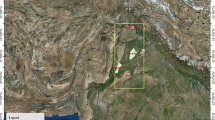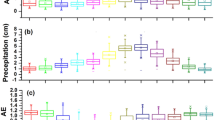Abstract
This study contains a comparative analysis of aerosol optical thickness (AOT) between numerical calculations obtained from the Navy Aerosol Analysis and Prediction System (NAAPS) model and direct observations from the AERONET robotic network and the Saharan Aerosol over WArsaw (SAWA) field campaign. AOT was calculated for 500 nm wavelength. The comparison shows underestimation of the total aerosol optical thickness simulated by NAAPS. The correlation coefficients between model and observation oscillates between 0.57 and 0.72. Results of seven-year (1998–2004) NAAPS simulation of aerosol components (sea salt, mineral dust, sulphate, and smoke) show large temporal and spatial variability of the aerosol optical thickness over Europe. The least polluted region is the Iberian Peninsula, while the highest aerosol burdens occurred in Central Europe, mostly due to anthropogenic sulphate particles. Finally, the analysis of mineral dust transport shows frequent episodes of Saharan dust inflow over Central Europe. There are about 20 days a year (4 days in May) when instantaneous AOT associated with mineral dust aerosol increases over 0.1.
Similar content being viewed by others
References
Anderson, J.R., E.E. Hardy, J.T. Roach, and R.E. Witmer (1976), A land use and land cover classification system for use with remote sensor data, Geol. Surv. Prof. Paper 964, 1–28.
Benkowitz, C.M., M.T. Scholtz, J. Pacyna, L. Tarrasón, J. Dignon, E.C. Voldner, P.A. Spiro, J.A. Logan, and T.E. Graedel (1996), Global gridded invento ries of anthropogenic emissions of sulfur and nitrogen, J. Geophys. Res. 101, D22, 29239–29253, DOI: 10.1029/96JD00126.
Bösenberg, J., V. Matthias, A. Amodeo, V. Amoiridis, A. Ansmann, J.M. Baldasano, I. Balin, C. Böckmann, A. Boselli, G. Carlsson, A. Chaykovski, G. Chourdakis, A. Comeron, F. DeTomasi, R. Eixmann, V. Freudenthaler, H. Giehl, I. Grigorov, A. Hågård, M. Iarlori, A. Kirsche, G. Kolarov, L. Komguem, S. Kreipl, W. Kumpf, G. Larchevêque, H. Linne, R. Matthey, I. Mattis, A. Mekler, I. Mironova, V. Mitev, L. Mona, D. Müller, S. Music, S. Nickovic, M. Pandolfi, A. Papayannis, G. Pappalardo, J. Pelon, C. Peres, R.M. Perrone, R. Persson, D.P. Resendes, V. Rizi, F. Rocadenbosch, J. Rodriguez, L. Sauvage, L. Schneidenbach, R. Schumacher, V. Shcherbakov, V. Simeonov, P. Sobolewski, N. Spinelli, I. Stachlewska, D. Stoyanov, T. Trickl, G. Tsaknakis, G. Vaughan, U. Wandinger, X. Wang, M. Wiegner, M. Zavrtanik, and C. Zerefos (2003), EARLINET: A European Aerosol Research Lidar Network to establish an aerosol climatology, MPI-Report, Max-Planck-Institute for Meteorology, Hamburg, Germany, 348 pp.
Charlson, R.J., S.E. Schwartz, J.M. Hales, R.D. Cess, J.A. Coakley, Jr., J.E. Hansen, and D.J. Hofmann (1992), Climate forcing by anthropogenic aerosols, Science 255, 5043, 423–430, DOI: 10.1126/science.255.5043.423.
Chin, M., P. Ginoux, S. Kinne, O. Torres, B.N. Holben, B.N. Duncan, R.V. Martin, J.A. Logan, A. Higurashi, and T. Nakajima (2002), Tropospheric aerosol optical thickness from the GOCART model and comparisons with satellite and sun photometer measurements, J. Atmos. Sci. 59, 3, 461–483, DOI: 10.1175/1520-0469(2002)059〈0461:TAOTFT〉2.0.CO;2.
Christensen, J.H. (1997), The Danish Eulerian Hemispheric Model — a three-dimensional air pollution model used for the Arctic, Atm. Env. 31, 24, 4169–4191, DOI: 10.1016/S1352-2310(97)00264-1.
Coakley, J.A., Jr., and R.D. Cess (1985), Response of the NCAR Community Climate Model to the radiative forcing by the naturally occurring tropospheric aerosol, J. Atmos. Sci. 42, 16, 1677–1692, DOI: 10.1175/1520-0469(1985)042〈1677:ROTNCC〉2.0.CO;2.
Debry, E., K. Fahey, K. Sartelet, B. Sportisse, and M. Tombette (2007), Technical note: A new SIze REsolved Aerosol Model (SIREAM), Atmos. Chem. Phys. 7, 1537–1547, DOI: 10.5194/acp-7-1537-2007.
Giglio, L., G.R. van der Werf, J.T. Randerson, G.J. Collatz, and P. Kasibhatla (2005), Global estimation of burned area using MODIS active fire observations, Atmos. Chem. Phys. Discuss. 5, 6, 11091–11141.
Giglio, L., I. Csiszar, and C.O. Justice (2006), Global distribution and seasonality of active fires as observed with the Terra and Aqua Moderate Resolution Imaging Spectroradiometer (MODIS) sensors, J. Geophys. Res. 111, G02016, DOI: 10.1029/2005JG000142.
Ginoux, P., L.W. Horowitz, V. Ramaswamy, I.V. Geogdzhayev, B.N. Holben, G. Stenchikov, and X. Tie (2006), Evaluation of aerosol distribution and optical depth in the Geophysical Fluid Dynamics Laboratory coupled model CM2.1 for present climate, J. Geophys. Res. 111, D22210, DOI: 10.1029/2005JD006707.
Grassl, H., and M. Newiger (1982), Changes of local planetary albedo by aerosol particles, Sci. Total Environ. 23, 313–320, DOI: 10.1016/0048-9697(82)90148-6.
Harrison, L., J. Michalsky, and J. Berndt (1994), Automated multifilter rotating shadow-band radiometer: an instrument for optical depth and radiation measurements, Appl. Optics 33, 22, 5118–5125, DOI: 10.1364/AO.33.005118.
Hess, M., P. Koepke, and I. Schult (1998), Optical Properties of Aerosols and Clouds: The software package OPAC, Bull. Am. Meteorol. Soc. 79, 5, 831–844, DOI: 10.1175/1520-0477(1998)079〈0831:OPOAAC〉2.0.CO;2.
Hogan, T.F., and T.E. Rosmond (1991), The description of the Navy Operational Global Atmospheric Prediction System’s spectral forecast model, Monthly Weather Rev. 119, 8, 1786–1815, DOI: 10.1175/1520-0493(1991)119〈1786:TDOTNO〉2.0.CO;2.
Holben, B.N., D. Tanré, A. Smirnov, T.F. Eck, I. Slutsker, N. Abuhassan, W.W. Newcomb, J.S. Schafer, B. Chatenet, F. Lavenu, Y.J. Kaufman, J.V. Castle, A. Setzer, B. Markham, D. Clark, R. Frouin, R. Halthore, A. Karneli, N.T. O’Neill, C. Pietras, R.T. Pinker, K. Voss, and G. Zibordi (2001), An emerging ground-based aerosol climatology: Aerosol optical depth from AERONET, J. Geophys. Res. 106, 12067–12098, DOI: 10.1029/2001JD900014.
IPCC (2007), Summary for Policymakers. In: S. Solomon, D. Qin, M. Manning, Z. Chen, M. Marquis, K.B. Averyt, M. Tignor, and H.L. Miller (eds.), Climate Change 2007: The Physical Science Basis. Contribution of Working Group I to the Fourth Assessment Report of the Intergovernmental Panel on Climate Change, Cambridge University Press, Cambridge, UK, and New York, NY, USA, http://www.ipcc.ch/SPM2feb07.pdf.
Markowicz, K.M., P.J. Flatau, A.E. Kardas, J. Remiszewska, K. Stelmaszczyk, and L. Woeste (2008), Ceilometer retrieval of the boundary layer vertical aerosol extinction structure, J. Atmos. Ocean. Tech. 25, 928–944, DOI: 10.1175/2007JTECHA1016.1.
Matthias, V. (2008), The aerosol distribution in Europe derived with the Community Multiscale Air Quality (CMAQ) model: comparison to near surface in situ and sunphotometer measurements, Atmos. Chem. Phys. Discuss. 8, 1457–1503.
McCormick, R.A., and J.H. Ludwig (1967), Climate modification by atmospheric aerosols, Science 156, 3780, 1358–1359, DOI: 10.1126/science.156.3780.1358.
Monahan, E.C., D.E. Spiel, and K.L. Davidson (1986), A model of marine aerosol generation via whitecaps and wave disruption. In: E.C. Monahan and G. MacNiocaill (eds.), Oceanic Whitecaps and Their Role in Air-Sea Exchange Processes, D. Reidel Publ. Co., Dordrecht, New York, 167–174.
Morys, M., F.M. Mims III, S. Hagerup, S.E. Anderson, A. Baker, J. Kia, and T. Walkup (2001), Design, calibration, and performance of MICROTOPS II handheld ozone monitor and Sun photometer, J. Geophys. Res. 106, D13, 14573–14582, DOI: 10.1029/2001JD900103.
Moulin, C., F. Dulac, C.E. Lambert, P. Chazette, I. Jankowiak, B. Chatenet, and F. Lavenu (1997), Long-term daily monitoring of Saharan dust load over ocean using Meteosat ISCCP-B2 data 2. Accuracy of the method and validation using Sun photometer measurements, J. Geophys. Res. 102, D14, 16959–16969, DOI: 10.1029/96JD02598.
Nickovic, S., G. Kallos, A. Papadopoulos, and O. Kakaliagou (2001), A model for prediction of desert dust cycle in the atmosphere, J. Geophys. Res. 106, D16, 18113–18129, DOI: 10.1029/2000JD900794.
Papayannis, A., V. Amiridis, L. Mona, G. Tsaknakis, D. Balis, J. Bösenberg, A. Chaikovski, F. De Tomasi, I. Grigorov, I. Mattis, V. Mitev, D. Müller, S. Nickovic, C. Pérez, A. Pietruczuk, G. Pisani, F. Ravetta, V. Rizi, M. Sicard, T. Trickl, M. Wiegner, M. Gerding, R.E. Mamouri, G. D’Amico, and G. Pappalardo (2008), Systematic lidar observations of Saharan dust over Europe in the frame of EARLINET (2000–2002), J. Geophys. Res. 113, D10204, DOI: 10.1029/2007JD009028.
Papayannis, A., R.E. Mamouri, V. Amiridis, S. Kazadzis, C. Pérez, G. Tsaknakis, P. Kokkalis, and J.M. Baldasano (2009), Systematic lidar observations of Saharan dust layers over Athens, Greece in the frame of EARLINET project (2004–2006), Ann. Geophys. 27, 3611–3620.
Redington, A.L., and R.G. Derwent (2002), Calculation of sulphate and nitrate aerosol concentrations over Europe using a Lagrangian dispersion model, Atmos. Environ. 36, 4425–4439, DOI: 10.1016/S1352-2310(02)00420-X.
Reid, J.S., E.J. Hyer, E.M. Prins, D.L. Westphal, J. Zhang, J. Wang, S.A. Christopher, C.A. Curtis, C.C. Schmidt, D.P. Eleuterio, K.A. Richardson, and J.P. Hoffman (2009), Global monitoring and forecasting of biomassburning smoke: Description of and lessons from the Fire Locating and Modeling of Burning Emissions (FLAMBE) Program, IEEE JSTARS 2, 3, 144–162, DOI: 10.1109/JSTARS.2009.2027443.
Schaap, M., M. van Loon, H.M. ten Brink, F.J. Dentener, and P.J.H. Builtjes (2004), Secondary inorganic aerosol simulations for Europe with special attention to nitrate, Atmos. Chem. Phys. 4, 857–874, DOI: 10.5194/acp-4-857-2004.
Smirnov, A., B.N. Holben, T.F. Eck, O. Dubovik, and I. Slutsker (2000), Clouds-creening and quality control algorithms for the AERONET database, Remote Sens. Environ. 73, 3, 337–349, DOI: 10.1016/S0034-4257(00)00109-7.
Tombette, M., P. Chazette, B. Sportisse, and Y. Roustan (2008), Simulation of aerosol optical properties over Europe with a 3-D size-resolved aerosol model: Comparisons with AERONET data, Atmos. Chem. Phys. 8, 7115–7132, DOI: 10.5194/acp-8-7115-2008.
Westphal, D.L., O.B. Toon, and T.N. Carlson (1988), A case study of mobilization and transport of Saharan dust, J. Atmos. Sci. 45, 15, 2145–2175, DOI: 10.1175/1520-0469(1988)045〈2145:ACSOMA〉2.0.CO;2
Witek, M.L., P.J. Flatau, P.K. Quinn, and D.L. Westphal (2007), Global sea-salt modeling: Results and validation against multicampaign shipboard measurements, J. Geophys. Res. 112, D08215, DOI: 10.1029/2006JD007779.
Author information
Authors and Affiliations
Corresponding author
Rights and permissions
About this article
Cite this article
Maciszewska, A.E., Markowicz, K.M. & Witek, M.L. A multiyear analysis of aerosol optical thickness over Europe and Central Poland using NAAPS model simulation. Acta Geophys. 58, 1147–1163 (2010). https://doi.org/10.2478/s11600-010-0034-5
Received:
Revised:
Accepted:
Published:
Issue Date:
DOI: https://doi.org/10.2478/s11600-010-0034-5




